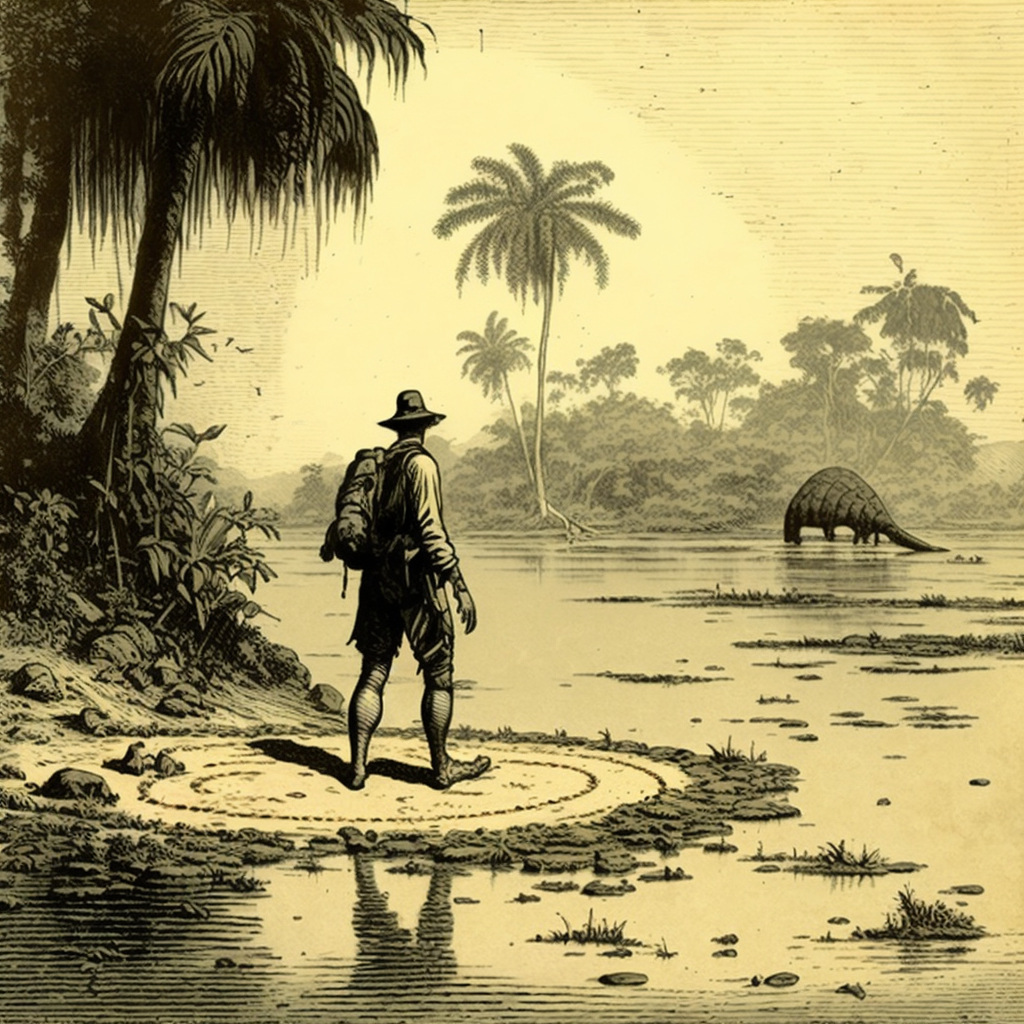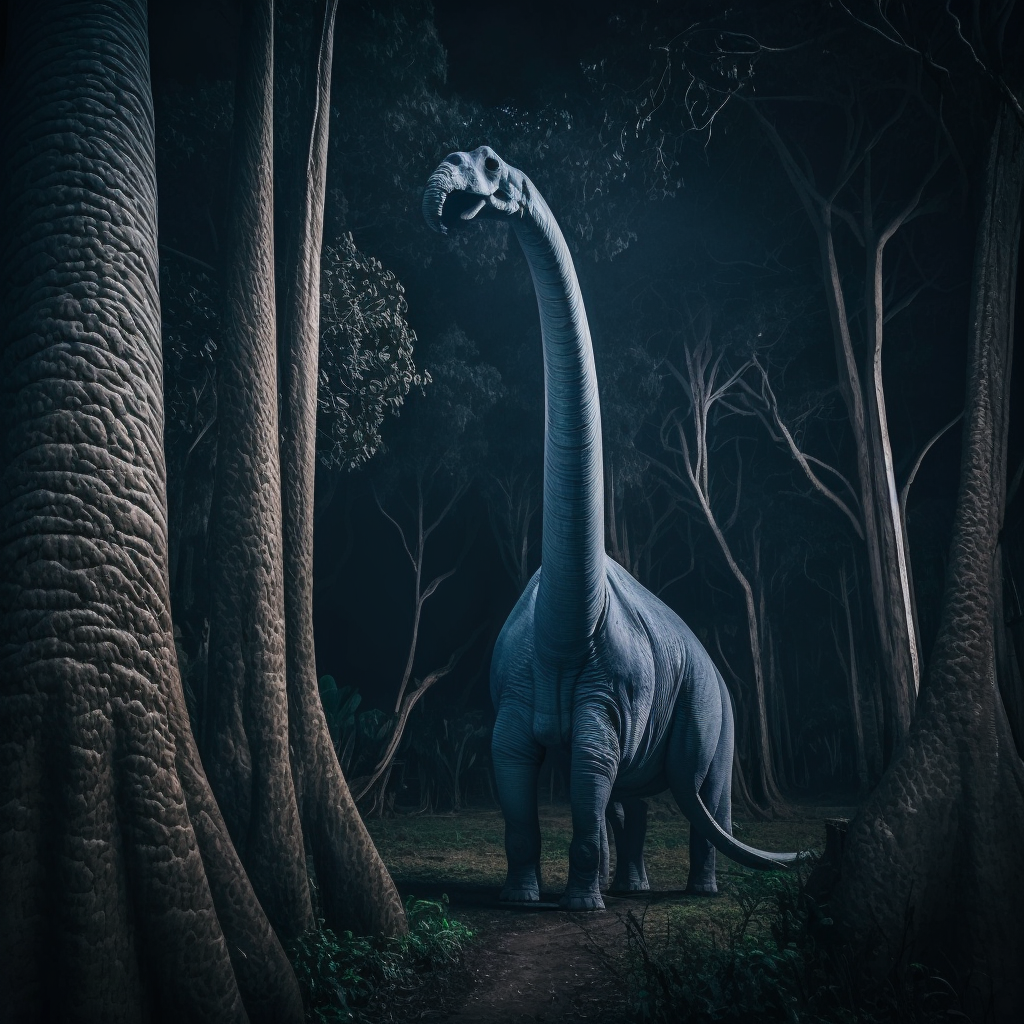For centuries, people living in the Congo region have shared stories of a mysterious creature, the Mokele-Mbembe.
This elusive being is said to resemble a long-necked dinosaur and has captured the imagination of both locals and researchers alike.
Weaving together sightings, folklore, and scientific inquiry, the search for the Mokele-Mbembe offers a fascinating glimpse into cryptozoology and our desire to uncover the unknown.
As we delve into the world of the Mokele-Mbembe, we will explore the various theories and explanations surrounding this enigmatic creature.
From the possibility of a surviving dinosaur species to misidentifications of known animals, there is no shortage of potential answers to the Mokele-Mbembe mystery.
Along the way, we will also encounter the societal and cultural impacts of this legend in the Congo region, shedding light on the power of myth and its enduring appeal.
Sightings and Reports
Early Expeditions

One of the first Westerners to report on the Mokele-Mbembe was a French missionary named Liévin-Bonaventure Proyart in 1776.
He described seeing enormous footprints measuring approximately one meter in diameter with claw marks in the Congo River region.
Throughout the years, several expeditions were conducted in search of this elusive creature.
These early expeditions returned with tales of encounters with the Mokele-Mbembe, but offered little concrete evidence.
Modern Accounts
In more recent times, reports of Mokele-Mbembe sightings have persisted, with locals and explorers alike claiming to have seen the elusive creature.
One notable incident occurred in 1999 when members of the Kabonga tribe were reported to have killed a Mokele-Mbembe.
In 1981, an expedition led by Herman Regusters returned from Lake Tele with intriguing findings: droppings, footprint casts, and sound recordings that did not match any known animal in the Congo Basin area.
Many reported sightings describe the creature as having a long neck and a small head, which it uses to feed on vegetation above water before submerging back into the depths.
The Mokele-Mbembe is often said to resemble a dinosaur, specifically a sauropod, due to its long neck and large body size.
Despite numerous expeditions and searches for the Mokele-Mbembe, definitive evidence of its existence remains elusive.
Aerial and satellite surveillance has been used to detect other large animals in the region but has not led to the discovery of any sauropod-like creatures.
Physical Description and Behavior
Appearance
The Mokele-Mbembe is often described as an enormous creature with a long neck and a small head, making it resemble a long-necked dinosaur such as a sauropod.
Its skin is said to be brownish-gray, and it is believed to be around 35 feet long.
Some descriptions also include a frill down its back, which is similar to the spikes that some paleontologists believe sauropods like Diplodocus possessed.
Habitat
The Mokele-Mbembe is said to inhabit the Congo Basin, particularly in the Lake Tele region, and it has also been associated with the former British colonial territory of Rhodesia (present-day Zambia and Zimbabwe).
In several accounts, the creature is described as an amphibious dweller, living both on land and in the water, with a preference for caves near rivers.
As such, its habitat would likely contain a mix of forested and aquatic areas, providing ample space for an animal of its size.
Diet
Based on various accounts, the Mokele-Mbembe is generally believed to be an herbivore.
Its preferred food source is said to be a certain type of liana, which is a vine-like plant that grows in tropical regions.
Lianas are abundant in the Congo Basin, providing an ample food supply for a creature of Mokele-Mbembe’s supposed size.
The lack of sharp teeth in the descriptions supports the herbivorous nature of the creature.
Possible Explanations

Unknown Species
One possible explanation for the Mokele-Mbembe sightings is that it could be an as-yet-undiscovered species.
The Congo region is vast, and its dense forests and swamps make it difficult to thoroughly explore.
We must consider the possibility that a large, unknown animal could be living there, hidden from human observation.
However, without concrete evidence such as genetic samples or clear photographs, this theory remains speculative.
Living Dinosaur Theory
Another popular theory surrounding the Mokele-Mbembe is that it might be a living dinosaur- specifically, a descendant of the sauropod family.
Its descriptions as a long-necked, herbivorous creature seem to align with what we know about these ancient animals.
On the other hand, some researchers argue that this interpretation might have roots in ‘dino-mania’ and the misreading of local legends during the early 1900s.
Furthermore, given the immense time span since the extinction of dinosaurs, it seems improbable that a single species could have survived for 65 million years without leaving any trace in the fossil record.
Misidentifications
A more plausible explanation for the sightings of Mokele-Mbembe is the misidentification of known animals.
The Congo is home to a variety of large, aquatic creatures, such as crocodiles, hippos, and elephants.
It is not unreasonable to assume that witnesses might have glimpsed one of these animals and misinterpreted its appearance or behavior.
For example, swimming elephants with their trunks above water could be mistaken for a long-necked creature.
In summary, the Mokele-Mbembe sightings could potentially be explained by an unknown species, the unlikely possibility of a living dinosaur, or misidentification of known animals.
Without definitive evidence, it remains a mystery that continues to capture the imagination and fuel debate amongst cryptozoologists and researchers alike.
Cultural Impact
Local Legends and Folklore
In African culture, the Mokele-Mbembe has often been passed down through generations as a mysterious creature inhabiting the remote regions of the Congo Basin.
The local tribespeople have various legends and stories about the Mokele-Mbembe, often describing it as a large reptile-like creature with a long neck and long tail, feared for its aggression towards humans.
The local people’s familiarity with the creature is evident in their artwork.
For example, Dr. Roy Mackal, a biologist and researcher of the Mokele-Mbembe, documented a carving from the 1980s depicting a long-necked, long-tailed animal, said to have been crafted by a Congolese artist.
These legends and cultural artifacts demonstrate the significant impact the Mokele-Mbembe has on the local communities living in the Congo Basin and surrounding areas.
Popular Media
Over the years, the Mokele-Mbembe has gained international attention, captivating both scientists and the general public alike.
Some documentaries and TV shows have explored the existence of this elusive creature, further embedding the legend into popular culture.
For instance, the popular TV show “MonsterQuest” dedicated an episode to investigating the Mokele-Mbembe, with a team of experts traveling to the Congo in search of evidence.
In literature, several books have been published on the subject, such as Dr. Roy Mackal’s “A Living Dinosaur?”, which documents his multiple expeditions and theories surrounding the Mokele-Mbembe.
The constant attention in media, documentaries, and books highlights the cultural impact of the Mokele-Mbembe legend on both local and global levels.
Scientific Investigations and Debates
We have come across various scientific investigations and debates surrounding the Mokele-Mbembe.
The existence of such a creature has fueled speculation about a possible surviving population of sauropod dinosaurs, with some identifying the Mokele-Mbembe as a possible Brontosaurus or Apatosaurus.
Reports of Mokele-Mbembe sightings go back to the eighteenth century, and numerous expeditions have been launched in search of this elusive creature.
The Smithsonian Institution sent a team to investigate in 1919, and since 1980, over 25 expeditions have been conducted (source).
Despite these efforts, no concrete evidence has been found to confirm the existence of the Mokele-Mbembe.
While many cryptozoologists remain hopeful that the Mokele-Mbembe is a living dinosaur, vertebrate paleontologists and other scientists are skeptical.
For example, Scientific American has argued that the classic depiction of the Mokele-Mbembe as an aquatic, swamp-dwelling sauropod may be based on misinterpretations of local legends and folklore.
Some alternative explanations for the sightings and stories surrounding the Mokele-Mbembe suggest that the creature could be a misidentified known animal, such as a large monitor lizard, an elephant, or even a manatee.
It is also worth noting that the Congo region is home to many unique and fascinating species, some of which are still being discovered by scientists.
Conclusion
In our investigation of the Mokele-Mbembe, we delved into the sightings and theories surrounding this elusive creature said to inhabit the Congo region.
The fascinating reports and descriptions of the Mokele-Mbembe often depict it as a large quadrupedal herbivore with a long neck and tail, resembling a long-necked dinosaur.
Throughout the years, the search for this creature has attracted the attention of cryptozoologists and explorers alike.
Researchers such as Roy Mackal and James Powell have even suggested that the Mokele-Mbembe could be a living dinosaur, similar to a known species like the Brontosaurus.
Although intriguing, it’s important to approach these claims with skepticism and consider alternative explanations.
Some experts have proposed that the sightings could be attributed to misidentifications of known animals, cultural influences, or even local folklore.
While the existence of the Mokele-Mbembe remains uncertain, our investigation demonstrates the complexity and intrigue surrounding this mysterious creature.
It is always important for us to rely on scientific evidence and maintain a rational perspective when exploring such legends.
Regardless of its true nature, the Mokele-Mbembe will undoubtedly continue to fascinate and inspire future explorations and discussions.

